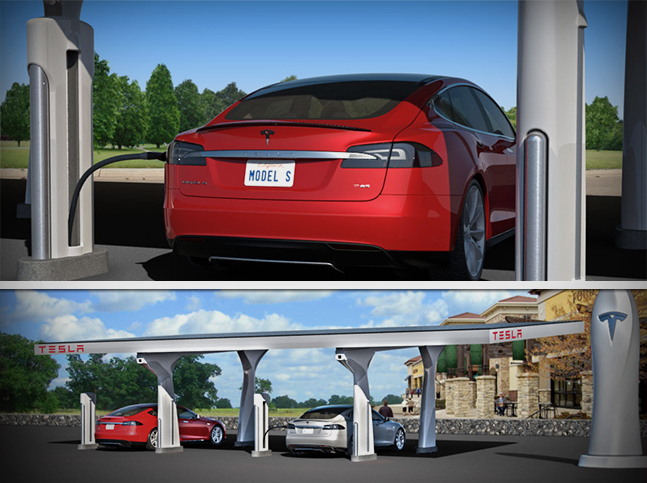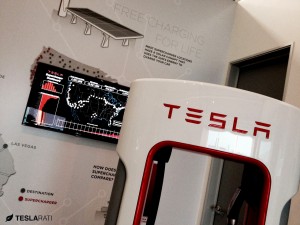News
Why Tesla wants to open its Supercharger to the competition

In a very bold move, Musk is considering opening the company’s intellectual property (IP) for its Superchargers inviting the competition in, breaking away from outmoded fights.
Just when you think you had Tesla figured out, Elon Musk, Tesla Motors’ CEO, throws in another bit to the overall electric vehicle (EV) picture, once again, changes the background.
Tesla embraces openness
The one thing almost all companies have in common is secrecy. Carmakers are no different and jealously keep trade secrets. What makes Tesla Motors unique and part of its success, is its engineering, which is off limit to GM, Ford and the rest. Companies edge out their products and services by keeping their know-how in-house in order to dominate a market, or a part of it. Even if some things are off limits, all carmakers pull apart others’ cars to see how they were engineered. If this was an effective strategy until now, it has its limits. Pushed to the maximum, it strangles markets and consumers are left to pay the price. There is less choice and innovations. Eventually, someone has to break the trends and breath new life. Is this what Tesla is trying to do? Not so fast.
Supercharge me and everyone else
Elon Musk says someone has to take the first step and Tesla Motors is the company to show the way forward. We couldn’t agree more. We’re tired of living in the stone age, we want a modern world that holds up to its promise and potential.
A company opening up the IP of its Supercharger network to create a “standard technical specification that other electric car makers can adopt,” as Engadget puts it, is a bold move forward.
But is it naïve, or simply a brilliant move forward when the competition is locked in a futile fight? The question is, who stands to gain the most from such a move.
 Tesla is willing give away some of its IP in order for other makers to charge at its Superchargers. It also hopes to by-pass the CHAdeMO and SAE fight, as well as the upcoming Chinese charging network with its own protocol. Tesla might charge a modest fee return, but that is nothing for such a juggernaut. Musk sees, as most of us do, that the automobile industry is in disarray and still grapples over how to create a thriving business model with electric vehicles (EV). If the industry, used to making internal combustion engines (ICE), it doesn’t know what to do with an electric motor and batteries, even less with a charging network. Luckily, Tesla took a lead early there.
Tesla is willing give away some of its IP in order for other makers to charge at its Superchargers. It also hopes to by-pass the CHAdeMO and SAE fight, as well as the upcoming Chinese charging network with its own protocol. Tesla might charge a modest fee return, but that is nothing for such a juggernaut. Musk sees, as most of us do, that the automobile industry is in disarray and still grapples over how to create a thriving business model with electric vehicles (EV). If the industry, used to making internal combustion engines (ICE), it doesn’t know what to do with an electric motor and batteries, even less with a charging network. Luckily, Tesla took a lead early there.
So far Nissan is one of the only carmaker to grow the network with CHAdeMO chargers at its dealerships. Then, there is the SAE Combo standard trying to muscle its way in, fighting against CHAdeMO. The absurd fight ended last year with a standstill, forcing once again consumers to choose one or the other, losing in the short run. So what can Tesla Motors do with its own Supercharger system watching another Chinese charger standard take advantage of the confusion? Open its doors and leapfrog the infighting competitors. It works to everyone’s advantage and the company comes out on top. Simple, brilliant, and so Tesla.
Standards come in two ways, officially, or de facto. For those of you seasoned enough to remember, we once had a choice between a good quality Betamax, and a rather inferior VHS system. VHS became a de facto standard after a deep pocket campaigns turned a generation on to it. The same almost happened to DVD recording, and there are plenty of other examples still. Tesla opening its IP doors to the competition is a bold move above the fray, and one we can be happy about since it will benefit the entire EV community. Hopefully, it will also stop this infighting caveman mentality companies have, pushing their visions on consumers. When you get down to it, what’s important is to have a nationwide charging network that works for as many cars as possible, regardless of makers, backers or other financial interests. Tesla does it again.

News
Tesla FSD fleet is nearing 7 billion total miles, including 2.5 billion city miles
As can be seen on Tesla’s official FSD webpage, vehicles equipped with the system have now navigated over 6.99 billion miles.

Tesla’s Full Self-Driving (Supervised) fleet is closing in on almost 7 billion total miles driven, as per data posted by the company on its official FSD webpage.
These figures hint at the massive scale of data fueling Tesla’s rapid FSD improvements, which have been quite notable as of late.
FSD mileage milestones
As can be seen on Tesla’s official FSD webpage, vehicles equipped with the system have now navigated over 6.99 billion miles. Tesla owner and avid FSD tester Whole Mars Catalog also shared a screenshot indicating that from the nearly 7 billion miles traveled by the FSD fleet, more than 2.5 billion miles were driven inside cities.
City miles are particularly valuable for complex urban scenarios like unprotected turns, pedestrian interactions, and traffic lights. This is also the difference-maker for FSD, as only complex solutions, such as Waymo’s self-driving taxis, operate similarly on inner-city streets. And even then, incidents such as the San Francisco blackouts have proven challenging for sensor-rich vehicles like Waymos.
Tesla’s data edge
Tesla has a number of advantages in the autonomous vehicle sector, one of which is the size of its fleet and the number of vehicles training FSD on real-world roads. Tesla’s nearly 7 billion FSD miles then allow the company to roll out updates that make its vehicles behave like they are being driven by experienced drivers, even if they are operating on their own.
So notable are Tesla’s improvements to FSD that NVIDIA Director of Robotics Jim Fan, after experiencing FSD v14, noted that the system is the first AI that passes what he described as a “Physical Turing Test.”
“Despite knowing exactly how robot learning works, I still find it magical watching the steering wheel turn by itself. First it feels surreal, next it becomes routine. Then, like the smartphone, taking it away actively hurts. This is how humanity gets rewired and glued to god-like technologies,” Fan wrote in a post on X.
News
Tesla starts showing how FSD will change lives in Europe
Local officials tested the system on narrow country roads and were impressed by FSD’s smooth, human-like driving, with some calling the service a game-changer for everyday life in areas that are far from urban centers.

Tesla has launched Europe’s first public shuttle service using Full Self-Driving (Supervised) in the rural Eifelkreis Bitburg-Prüm region of Germany, demonstrating how the technology can restore independence and mobility for people who struggle with limited transport options.
Local officials tested the system on narrow country roads and were impressed by FSD’s smooth, human-like driving, with some calling the service a game-changer for everyday life in areas that are far from urban centers.
Officials see real impact on rural residents
Arzfeld Mayor Johannes Kuhl and District Administrator Andreas Kruppert personally tested the Tesla shuttle service. This allowed them to see just how well FSD navigated winding lanes and rural roads confidently. Kruppert said, “Autonomous driving sounds like science fiction to many, but we simply see here that it works totally well in rural regions too.” Kuhl, for his part, also noted that FSD “feels like a very experienced driver.”
The pilot complements the area’s “Citizen Bus” program, which provides on-demand rides for elderly residents who can no longer drive themselves. Tesla Europe shared a video of a demonstration of the service, highlighting how FSD gives people their freedom back, even in places where public transport is not as prevalent.
What the Ministry for Economic Affairs and Transport says
Rhineland-Palatinate’s Minister Daniela Schmitt supported the project, praising the collaboration that made this “first of its kind in Europe” possible. As per the ministry, the rural rollout for the service shows FSD’s potential beyond major cities, and it delivers tangible benefits like grocery runs, doctor visits, and social connections for isolated residents.
“Reliable and flexible mobility is especially vital in rural areas. With the launch of a shuttle service using self-driving vehicles (FSD supervised) by Tesla in the Eifelkreis Bitburg-Prüm, an innovative pilot project is now getting underway that complements local community bus services. It is the first project of its kind in Europe.
“The result is a real gain for rural mobility: greater accessibility, more flexibility and tangible benefits for everyday life. A strong signal for innovation, cooperation and future-oriented mobility beyond urban centers,” the ministry wrote in a LinkedIn post.
News
Tesla China quietly posts Robotaxi-related job listing
Tesla China is currently seeking a Low Voltage Electrical Engineer to work on circuit board design for the company’s autonomous vehicles.

Tesla has posted a new job listing in Shanghai explicitly tied to its Robotaxi program, fueling speculation that the company is preparing to launch its dedicated autonomous ride-hailing service in China.
As noted in the listing, Tesla China is currently seeking a Low Voltage Electrical Engineer to work on circuit board design for the company’s autonomous vehicles.
Robotaxi-specific role
The listing, which was shared on social media platform X by industry watcher @tslaming, suggested that Tesla China is looking to fill the role urgently. The job listing itself specifically mentions that the person hired for the role will be working on the Low Voltage Hardware team, which would design the circuit boards that would serve as the nervous system of the Robotaxi.
Key tasks for the role, as indicated in the job listing, include collaboration with PCB layout, firmware, mechanical, program management, and validation teams, among other responsibilities. The role is based in Shanghai.
China Robotaxi launch
China represents a massive potential market for robotaxis, with its dense urban centers and supportive policies in select cities. Tesla has limited permission to roll out FSD in the country, though despite this, its vehicles have been hailed as among the best in the market when it comes to autonomous features. So far, at least, it appears that China supports Tesla’s FSD and Robotaxi rollout.
This was hinted at in November, when Tesla brought the Cybercab to the 8th China International Import Expo (CIIE) in Shanghai, marking the first time that the autonomous two-seater was brought to the Asia-Pacific region. The vehicle, despite not having a release date in China, received a significant amount of interest among the event’s attendees.









